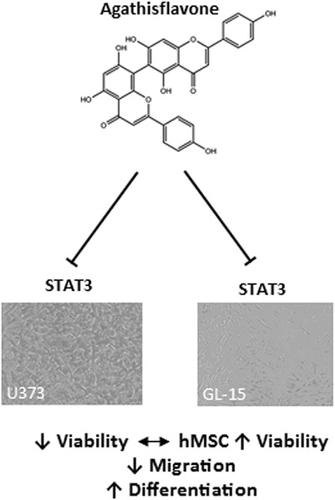当前位置:
X-MOL 学术
›
J. Cell. Physiol.
›
论文详情
Our official English website, www.x-mol.net, welcomes your
feedback! (Note: you will need to create a separate account there.)
Reverted effect of mesenchymal stem cells in glioblastoma treated with agathisflavone and its selective antitumoral effect on cell viability, migration, and differentiation via STAT3
Journal of Cellular Physiology ( IF 4.5 ) Pub Date : 2020-12-23 , DOI: 10.1002/jcp.30209 Ravena P Nascimento 1, 2 , Balbino L Dos Santos 1, 3 , Karina C da Silva 1 , Victor D Amaral da Silva 1, 4 , Maria de Fátima Costa 1, 4 , Jorge M David 5 , Juceni P David 6 , Vivaldo Moura-Neto 4, 7 , Mona das N Oliveira 8 , Henning Ulrich 8 , Giselle P de Faria Lopes 9 , Silvia L Costa 1, 4
Journal of Cellular Physiology ( IF 4.5 ) Pub Date : 2020-12-23 , DOI: 10.1002/jcp.30209 Ravena P Nascimento 1, 2 , Balbino L Dos Santos 1, 3 , Karina C da Silva 1 , Victor D Amaral da Silva 1, 4 , Maria de Fátima Costa 1, 4 , Jorge M David 5 , Juceni P David 6 , Vivaldo Moura-Neto 4, 7 , Mona das N Oliveira 8 , Henning Ulrich 8 , Giselle P de Faria Lopes 9 , Silvia L Costa 1, 4
Affiliation

|
Glioblastoma is the most lethal tumor of the central nervous system, presenting a very poor prognostic, with a survival around 16 months. The interaction of mesenchymal stem cells and tumor cells has been studied, showing a bias in their role favoring or going against aggressiveness. Natural products such as flavonoids have showed their anticancer properties and the synergic potential with the activation of microenvironment cells to inhibit tumor progression. Agathisflavone is a flavonoid studied in neurodegenerative diseases and cancer. The present study investigated the effect of flavonoid in the viability of heterogeneous glioblastoma (GBM) cells considering a coculture or conditioned medium of mesenchymal stem cells (MSCs) effect, as well as the dose‐dependent effect of this flavonoid in tumor migration and differentiation via STAT3. Agathisflavone (3–10 μM) induced dose‐dependent toxicity to GL‐15 and U373 human GBM cells, since 24 h after treatments. It was not toxic to human MSC but modified the pattern of interaction with GBM cells. Agathisflavone also inhibited migration and increased differentiation of human GBM cells, associated with the reduction on the expression of STAT3. These results demonstrate that the flavonoid agathisflavone had a direct anti‐glioma effect. However, could be observed its effect in MSCs response that may have an impact in controlling GBM growth and aggressiveness, an important factor to consider for new therapies.
中文翻译:

间充质干细胞在用 agathisflavone 治疗的胶质母细胞瘤中的恢复作用及其通过 STAT3 对细胞活力、迁移和分化的选择性抗肿瘤作用
胶质母细胞瘤是中枢神经系统中最致命的肿瘤,预后极差,生存期约为 16 个月。已经研究了间充质干细胞和肿瘤细胞的相互作用,表明它们的作用有利于或反对侵袭性。类黄酮等天然产物已显示出其抗癌特性以及与激活微环境细胞以抑制肿瘤进展的协同潜力。Agathisflavone 是一种在神经退行性疾病和癌症中研究的黄酮类化合物。本研究考虑了间充质干细胞 (MSC) 效应的共培养或条件培养基,研究了黄酮类化合物对异质性胶质母细胞瘤 (GBM) 细胞活力的影响,以及这种黄酮类化合物在肿瘤迁移和分化中的剂量依赖性效应状态3。自治疗后 24 小时起,阿加西黄酮 (3-10 μM) 对 GL-15 和 U373 人 GBM 细胞诱导剂量依赖性毒性。它对人类 MSC 没有毒性,但改变了与 GBM 细胞的相互作用模式。Agathisflavone 还抑制人类 GBM 细胞的迁移和增加的分化,这与 STAT3 表达的减少有关。这些结果表明,黄酮类化合物 agathisflavone 具有直接的抗神经胶质瘤作用。然而,可以观察到它对 MSCs 反应的影响,这可能对控制 GBM 生长和侵袭性产生影响,这是新疗法需要考虑的重要因素。Agathisflavone 还抑制人类 GBM 细胞的迁移和增加的分化,这与 STAT3 表达的减少有关。这些结果表明,黄酮类化合物 agathisflavone 具有直接的抗神经胶质瘤作用。然而,可以观察到它对 MSCs 反应的影响,这可能对控制 GBM 生长和侵袭性产生影响,这是新疗法需要考虑的重要因素。Agathisflavone 还抑制人类 GBM 细胞的迁移和增加的分化,这与 STAT3 表达的减少有关。这些结果表明,黄酮类化合物agathisflavone 具有直接的抗神经胶质瘤作用。然而,可以观察到它对 MSCs 反应的影响,这可能对控制 GBM 生长和侵袭性产生影响,这是新疗法需要考虑的重要因素。
更新日期:2020-12-23
中文翻译:

间充质干细胞在用 agathisflavone 治疗的胶质母细胞瘤中的恢复作用及其通过 STAT3 对细胞活力、迁移和分化的选择性抗肿瘤作用
胶质母细胞瘤是中枢神经系统中最致命的肿瘤,预后极差,生存期约为 16 个月。已经研究了间充质干细胞和肿瘤细胞的相互作用,表明它们的作用有利于或反对侵袭性。类黄酮等天然产物已显示出其抗癌特性以及与激活微环境细胞以抑制肿瘤进展的协同潜力。Agathisflavone 是一种在神经退行性疾病和癌症中研究的黄酮类化合物。本研究考虑了间充质干细胞 (MSC) 效应的共培养或条件培养基,研究了黄酮类化合物对异质性胶质母细胞瘤 (GBM) 细胞活力的影响,以及这种黄酮类化合物在肿瘤迁移和分化中的剂量依赖性效应状态3。自治疗后 24 小时起,阿加西黄酮 (3-10 μM) 对 GL-15 和 U373 人 GBM 细胞诱导剂量依赖性毒性。它对人类 MSC 没有毒性,但改变了与 GBM 细胞的相互作用模式。Agathisflavone 还抑制人类 GBM 细胞的迁移和增加的分化,这与 STAT3 表达的减少有关。这些结果表明,黄酮类化合物 agathisflavone 具有直接的抗神经胶质瘤作用。然而,可以观察到它对 MSCs 反应的影响,这可能对控制 GBM 生长和侵袭性产生影响,这是新疗法需要考虑的重要因素。Agathisflavone 还抑制人类 GBM 细胞的迁移和增加的分化,这与 STAT3 表达的减少有关。这些结果表明,黄酮类化合物 agathisflavone 具有直接的抗神经胶质瘤作用。然而,可以观察到它对 MSCs 反应的影响,这可能对控制 GBM 生长和侵袭性产生影响,这是新疗法需要考虑的重要因素。Agathisflavone 还抑制人类 GBM 细胞的迁移和增加的分化,这与 STAT3 表达的减少有关。这些结果表明,黄酮类化合物agathisflavone 具有直接的抗神经胶质瘤作用。然而,可以观察到它对 MSCs 反应的影响,这可能对控制 GBM 生长和侵袭性产生影响,这是新疗法需要考虑的重要因素。











































 京公网安备 11010802027423号
京公网安备 11010802027423号